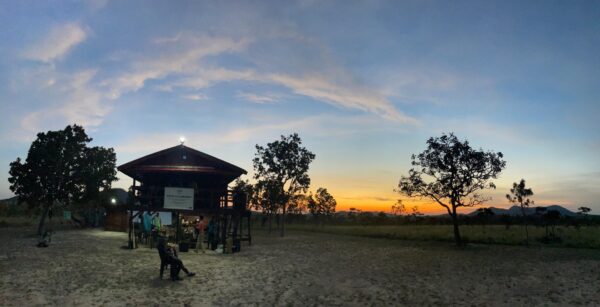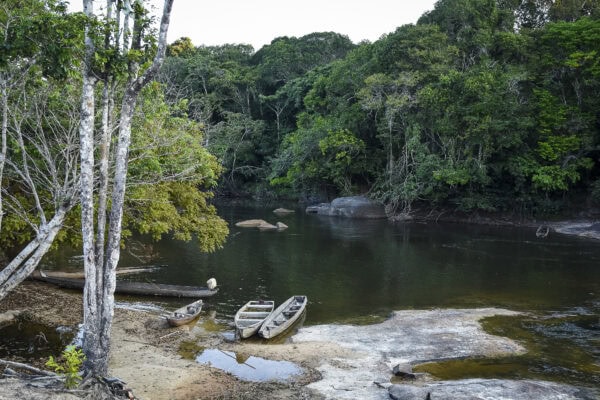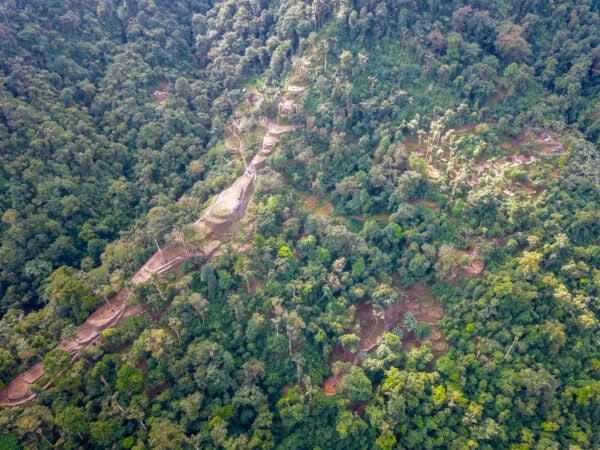November 10, 2020
By Adriana Díaz
It was 4 a.m. on Monday, October 5. Jaime Gutiérrez was arriving at the El Dorado airport in Bogotá, which had resumed commercial flights a few weeks earlier. He went through the controls imposed by the Covid-19 pandemic: fill out the CoronApp application, have one’s temperature taken, and line up at the airline, which required all luggage to be in the hold. His destination was Villagarzón (Putumayo), and from there, Mocoa, the capital of the department, which he would arrive at around 9 in the morning.
Ten hours later, at 7 o’clock the next day, 550 kilometers south of Bogotá, Jimmy Sanjuan set out on a journey to the same destination as Jaime. He left the main dock in Puerto Leguízamo in one of the “blue balsa” boats, which after almost nine hours of sailing on the Putumayo River would take him to Puerto Asís. From there, it was three more hours by road to Mocoa, where he arrived at 8:30 at night.
Jaime and Jimmy, who would meet on October 7, shared the same motivation for the trip: to help as volunteers in managing the pandemic. Jaime, 43 years old, is a doctor from Barranquilla, and a health brigade member at the Universidad de los Andes. Jimmy, 32 years old, is a mayor of the Comuyamena community, made up of 19 families from the Murui people, and a nursing assistant.
The meeting point was “La chagra de la vida”, the headquarters of ASOMI, an association of indigenous women, which since 2004 has been working to recover the identity, knowledge, and traditional practices of the cultures to which its members belong. They offered the location where the “Training workshop on epidemiological monitoring for indigenous assistants for the containment of Covid-19 in indigenous communities of Putumayo” was held, organized by the Departmental Health Secretariat, in which health brigade members from the Universidad de los Andes participated and which was coordinated by the NGO the Amazon Conservation Team (ACT), which has been in the region for multiple years supporting indigenous organizational processes, including that of ASOMI.
And the virus arrived
“In March, the total lockdown was put in place, and we were taken by surprise, because first there were only mild symptoms—one drank some water, one took an herbal remedy, and it passed. Things got worse. In Peru and Ecuador, the lockdown was imposed, and everyone from those borderlands came to the market in Puerto Leguízamo, and were already infected with Covid-19. After 15 days, the mortality began, and we could do almost nothing. We said goodbye to four elders of the Murui people, who were a library in matters of culture, history, tradition, and medicine,” says Jimmy regarding what his community experienced those first months after the arrival of the SARS-CoV-2 virus in the country.
At that time, in the Putumayo Departmental Public Health Laboratory, Alejandra Enríquez, its coordinator, and the bacteriologist with whom she worked were preparing through online tutorials to take samples with the nasopharyngeal swab technique. “It is not a common practice. With H1N1, very few samples were taken in Putumayo, and there was not much knowledge, and that which we observed at the university we did not remember well,” says Alejandra.
While Alejandra and Jimmy endured confinement with the difficulties that geographical distance and lack of resources imposed on them, in Bogotá, Jaime answered the call of Martha Vives, vice dean of Sciences at the Universidad de los Andes (Uniandes), who wanted to form a brigade to take samples with the technique that Alejandra was searching for on the internet. A brigade that would later become a fundamental part of the Covida project, through which Uniandes searches for the virus, especially in people who do not have symptoms, in order to contribute to the management of the epidemic. “Although I haven’t worked as a doctor for seven years, I felt the need to contribute. I have knowledge that I acquired in my privileged life, and it is only fair to help my society,” says Jaime, recalling the initial days of the pandemic.
As a doctor, he taught his five companions. Two of them, Ángela Holguín and Santiago Hernández, traveled to Mocoa at the end of June and, with the experience accumulated in two months of taking samples, trained health personnel from various hospitals and five people from the team, now expanded, from the Public Health Laboratory. “For us, it was a great gift, because they resolved many questions that we had from the tutorials”, says Alejandra.
By that date, the end of June, the National Organization of the Indigenous Peoples of the Colombian Amazon (OPIAC) had won a court ruling in which they asked the Colombian government and the governors of the six departments (Amazonas, Caquetá, Guainía, Guaviare, Putumayo and Vaupés) to develop a consensus-based plan with a differential approach for the indigenous peoples of the region in the face of the health emergency caused by Covid-19.
The workshop in which Jimmy and Jaime met in October was framed in that ruling.
Intercultural Dialogue
In the 13 municipalities of Putumayo, there are 15 indigenous peoples. The great concern in the face of the pandemic is what Jimmy’s community has already experienced: the death of their elders and, with that, the risk of losing their culture. “There are our elders; they possess all of our worldview and culture. We need to know if the community is becoming infected,” explained Nelcy Timarán, from the Inga people, who together with Víctor Quenama, from the Cofán people, is the delegate of the indigenous peoples to the Putumayo Health Department. There, they act as a bridge between cultures: the western, and those of the indigenous peoples.
The challenge is great, and this was noted by the anthropologist Paula Galeano, the ACT Putumayo Program coordinator, in the introduction to the work that awaited them that week. “Local history teaches us that we have to be together in this situation, and we have to build trust.” She says it with authority: she has been working in the region for 11 years, first in ethnoeducation and then assisting territorial processes that require the coordination of multiple actors, as in this workshop.
In that first dialogue, the complexity of addressing the pandemic emerged in a cultural context different from that of Western standards. Voices were heard from all sides. The isolation. Indigenous peoples live as a community, they all isolate together, not as an individual. “They take refuge outside, not within the community,” Paula commented. “It is easier to get them to take the test than to impose isolation, given that in most families, they live in the same room,” Nelcy added. Why don’t they go to the hospital? “They are afraid that they will be intubated, that they will become very thirsty and will not be given water,” said Victor.
The conversation about the notifications of results also lasted several minutes. “The governor wants to know, if he grants permission to enter the community, if he will be able to observe the process,” said Nelcy. “It cannot be done, the result is personal—because of habeas data, it is impossible,” said health department officials. There must be permission to enter the reserve, informed consent, notification to Sivigila (the public health monitoring system), and a means of reporting from the geographically dispersed communities. Víctor then explained: “For example, we test an elder, and it comes out positive. Someone has to translate that.” In the end, three different documents were produced for the process, with bacteriologists monitoring Whatsapp to receive photos of the results, to the extent that connectivity permits.
Through that first conversation, the workshop was completed, which included an overview of the impact of Covid-19 on the indigenous peoples of Putumayo: through September 15, 446 cases according to bulletin 48 of the Territorial Monitoring System of the National Indigenous Organization of Colombia. It also included formats for collecting information, nasopharyngeal swab sampling, use of personal protective equipment, and reading of antigen tests. The key, according to Paula: that the 23 participating indigenous health aides were informed, trained, and authorized by their communities to take the tests. 2,500 tests, adding together those for antigen and PCR, are dedicated to indigenous communities, said Alejandra Enríquez.
“They say that it is difficult to enter the communities with these matters, but you just have to come with love and have the will to always listen with respect,” said Leidy Carvajal, Jimmy’s traveling companion, also from the Murui people.
Learning by doing
The training created by the Uniandes health brigade to take samples to be processed by molecular analysis (PCR) is above all practical. It was born mainly from experience: from April 18 to October 1, there were 1,285 hours of work among the six brigade members. They know that you learn by doing, and therefore, from the outset, Jaime tells his audience: “Today, everyone has to take a sample.” Nervous laughter is heard in response.
First, the brigade member Tatiana Morales, a chemist and Jaime’s traveling companion, dons the personal protection elements in order, one by one: this is vital to ensure the safety of the person taking the sample and of the participants. They then explain what to say to people and how to reassure them if they are afraid. Confirm the person’s name and identity document, ask if he has had or has a problem with his nose, invite him to inhale first through one nostril and then through the other to find out which one is breathing better at that moment, and explain that the test has no risk and that it’s a bit awkward. “Put your feet flat on the floor, tilt your head back a little, don’t move.” Jaime takes a swab and shows a volunteer how and how far to insert it, and how many times to turn it. This is aided by an image of the nasal cavity projected on the wall. The assistants visually follow their hands without missing a movement: how one opens the swab, how one guards the end of the swab where the sample is placed in a tube. Then comes the packaging of that tube, previously labeled with the data of each person. It is a detailed process that demands one’s full attention.
Who will go first? Jaime asks. The group from Puerto Leguízamo goes to the front. Ángela Gómez will take the sample from Leidy, and Jimmy will be her assistant. Then they will rotate. Jaime and Tatiana watch each step and remind them if they forget something.
Angela leaves happy; it is the first time that she has taken this type of sample in her 10 years of experience as a nurse. “These are the workshops in which one learns. Jaime is very aware that one must do the right things. It scared me at first to cause someone discomfort, but that feeling has already passed,” she says at the end.
For Jaime, this is a very significant day due to the presence of traditional knowledge, which is different from the western kind, and a system with which he no familiarity. This volunteering is, in addition to a means of helping, an opportunity to get out of his comfort zone and to brave teaching, something that, he says, is difficult for him. “It’s an experience that helps me to recognize myself, and to see things that I haven’t yet expressed,” he reflects as if to himself. Jimmy, the last of his group to take the sample, is satisfied: “We have to learn to teach in our communities.”
Three weeks after the workshop, I speak with Jimmy, this time over the phone. The brigades to take samples have not yet commenced.
Media Relations
For press release inquiries, please contact us at info@amazonteam.org.
Related Articles
Share this post
Bring awareness to our projects and mission by sharing this post with your friends.




